» Jump to recipes using Winter Squash as an ingredient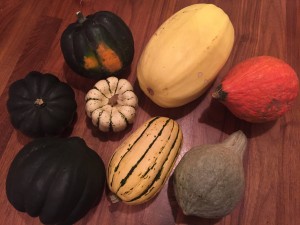 There are so many varieties of winter squash, it seems futile to try to list them all here. We’ll try to give a synopsis of some of the more common CSA varieties, and hopefully one can get an idea how to work with any squash from there.
There are so many varieties of winter squash, it seems futile to try to list them all here. We’ll try to give a synopsis of some of the more common CSA varieties, and hopefully one can get an idea how to work with any squash from there.
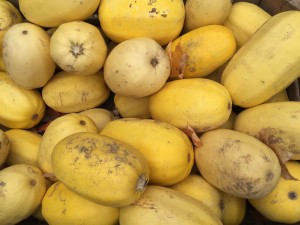
Spaghetti Squash – This one is fabulous as a substitution in many noodle and pasta dishes. Just bake until tender and comb out the de-seeded center with a fork!
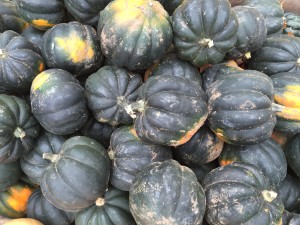
The infamous acorn squash. Named for it’s shape but with an accompanying nuttiness, these will store for up to 2 months (sometimes longer). A good one for quick roasting and pureeing. The puree is subtle enough to sneak into many dishes such as chilis, pasta sauces, and baked goods!
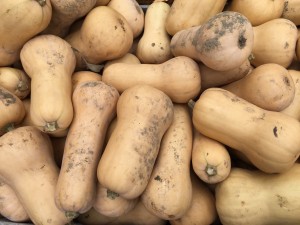
Butternut squash, this is the original gangster. If “cured” (the very process of toughening the skin for storage), these sweet beauties will keep for up to 6 months in cold storage.
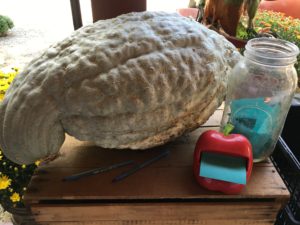
Blue Hubbard is the behemoth of the squashes. It’s a great one for storing over the winter, up to six months in the right conditions. When you’re ready to eat it, wrap it in a towel and throw it down some stairs or in your driveway to get some nice roastable pieces. It’ll be much easier than trying to cut it open.(Thanks to our Fellow Springdellians for this tip!)
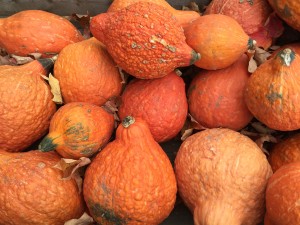
Red Kuri squash. Jess loves these cooked in slices and served as “steaks” on eggs. Red Kuris can be almost indistinguishable from Golden Hubbards, with one major difference. The skin can be consumed on a Red Kuri while the Golden Hubbard’s skin can not. Ask Farmer Jamie if you have trouble distinguishing!
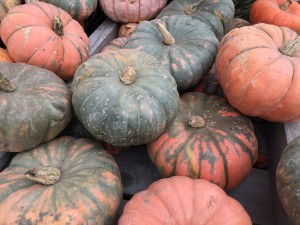
Speckled Hound – this variety looks similar to a Cinderella pumpkin. The cavity is much less hollow, making it a perfect vessel for fondue when roasted.
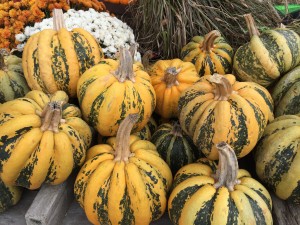
Cameo Squash. Another interesting and tasty variety.
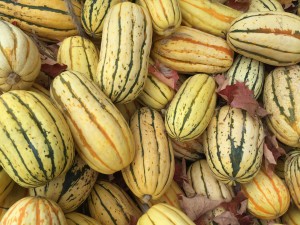
Delicata – delicate in flavor as the name implies. This variety should be eaten first as it does not keep as long as some of the tougher skinned ones. The sweet flavor accompanied with the tender and aesthetically pleasing skin makes it a perfect side dish for that special occasion. Stuff it, bake it whole, or slice it into crescents and roast to bring out that lovely flavor.
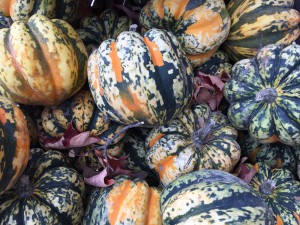
Dumpling Squash- Similar to the Carnival variety.
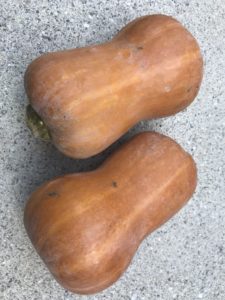
Honeynut Squash!- These mini-butternuts are relatively new to the area. Honeynuts are like a concentration of all the goodness of a butternut squash. The flesh is a bit more orange, and a bit sweeter, denser, nuttier.
Regarding Storage –
Cold storage is not nearly as complicated as it sounds, and can take some experimentation to find the best spots to store in your house, temperature-wise (low 50’s) and humidity-wise (60%). My “sweet spots” are in an inner room in our garage, and in the basement near and in the bulkhead.
Some squashes do better with “hardening” first, to toughen their skins up a bit for longer storage (butternut, hubbards, and red kuri’s can store for MONTHS after being hardened). The only problem is that hardening takes them being in the heat for a week and it’s gotten cold out, (I hardened many of mine on a table in the sun in October). It’s not the end of the world if hardening didn’t happen, some of the squash have been kind of hardened already by being in the farmstand bins.
Not all squashes need to be hardened to store, acorn squashes for example generally do not respond well to hardening. Acorns can also tolerate slightly colder temps than the low 50s (sometimes I put them in my bulkhead). Acorns generally keep for up to a month or so but I’ve kept them twice as long and they’ve held up well. If the skin starts turning orange, like, in more than one spot, it’s a signal to use them. If they are ready to use before I am, I’ll roast, puree and freeze them for later use.

I love these milk crates for squash storage as they allow the squash to “breathe” underneath. Be sure NOT to take the crates from the farm though!
Cold storage usually involves checking the squash every few days, as one blemished squash can take a bunch down with it quickly. Use the blemished ones up right away and keep them away from their buddies. Ideally storing the squash in a single layer is best (off the basement floor), but I keep mine stacked in small crates, since I move them around if the temperature shifts drastically.
Bonnie Plants has an informative page on storing winter squash here.
This link also provides an excellent one-page synopsis on squash storage.
—
Click on this link to see Sarah’s squash freezing method – posted January 7, 2015
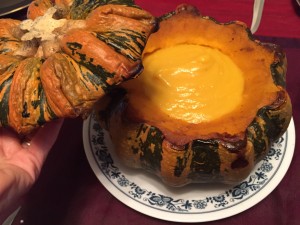
Roasted Cameo Squashes make awesome soup tureens. Here’s one file with butternut squash soup.
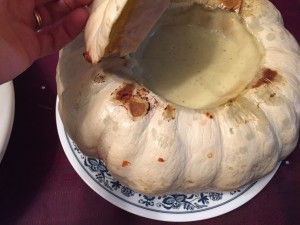
Here’s a mystery squash filled with a potato leek soup.
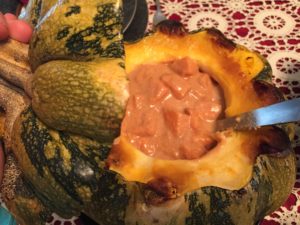
Here’s another filled with Sweet Potato Peanut Stew. We love these!
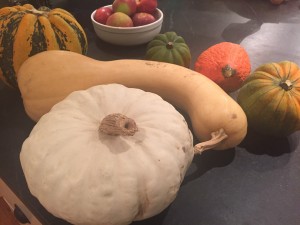
At any rate, winter squash come in countless varieties and we are always surprised with what we find in the share box. You can use the above directory as a guideline, but don’t be afraid to experiment and get creative!
Recipes Using Winter Squash
This is an Anderson family favorite, perfect for when the spaghetti squash season rolls around. Soy sauce or tamari can substitute fish sauce if you want to keep it vegetarian. Tamarind paste can be substituted for rice wine vinegar as well, but the real deal is best. Give yourself time to drain the tofu and make the squash, but the pad thai itself is quick to make.
This recipe is my favorite way to conquer a whole Hubbard squash. It makes 2 pies (calling for 2 prepared pie crusts) and if there’s extra squash, a side dish. It takes about 2 1/2 hours including squash roasting and pie baking time, but it can be made in stages, so don’t feel like you need to do this whole thing start-to-finish in one wallop. If you have any puree left over, enjoy it with maple syrup and Amish Roll Butter!
Do you like Thai curry? How about the warm and comforting flavor of Massaman curry? If so, this dish may be for you! I called it pumpkin curry in the title because that’s how I originally started making it, but as you can see this version has delicata squash. Really, any winter squash will do. Carrots and potatoes are great also if you have them on hand. This recipe lends itself to a slow cooker, instant pot, or stovetop. Make it with chicken or as a vegetarian dish. There are tips in the post to make it your own. I hope you enjoy it as much as I do!




















